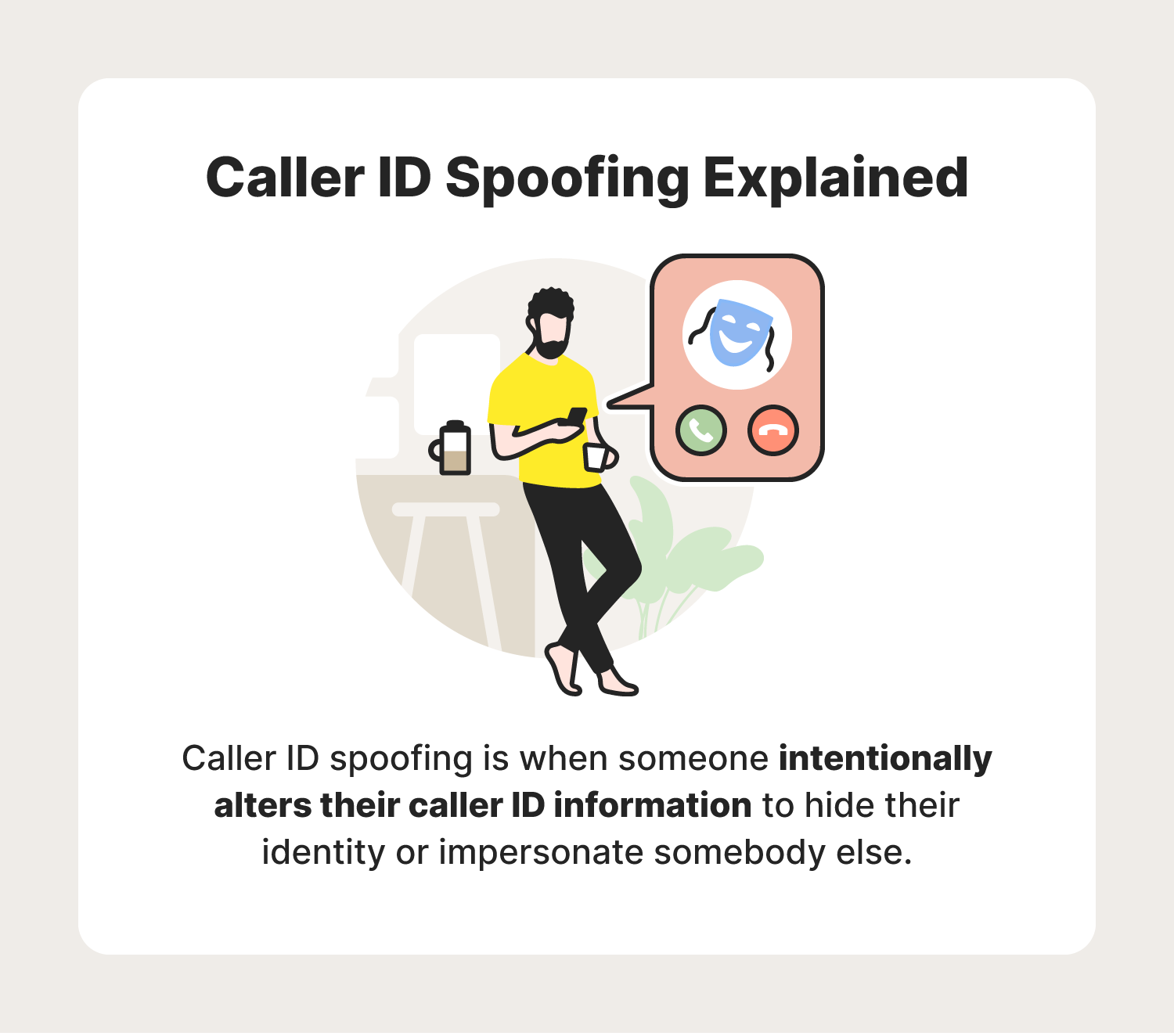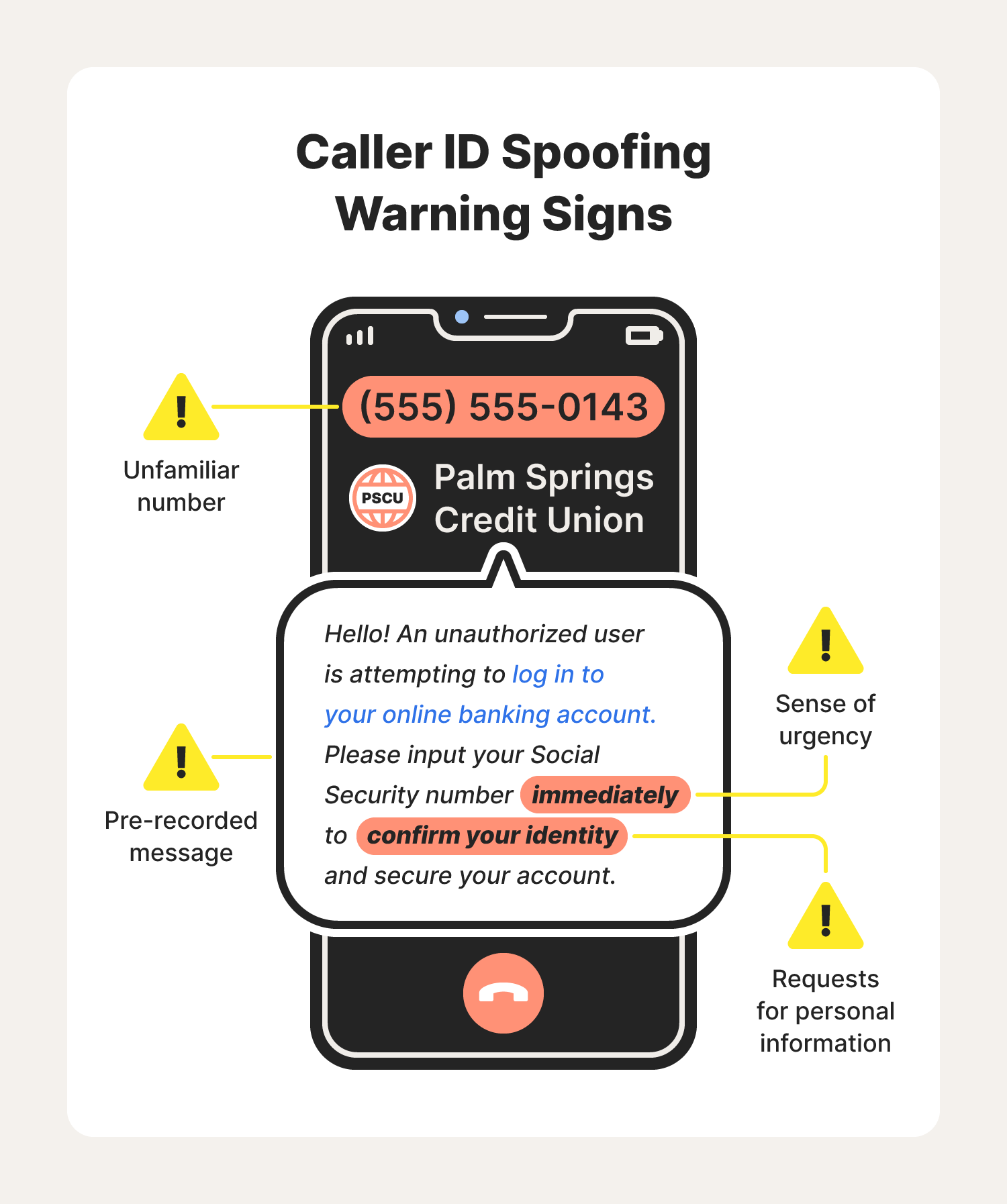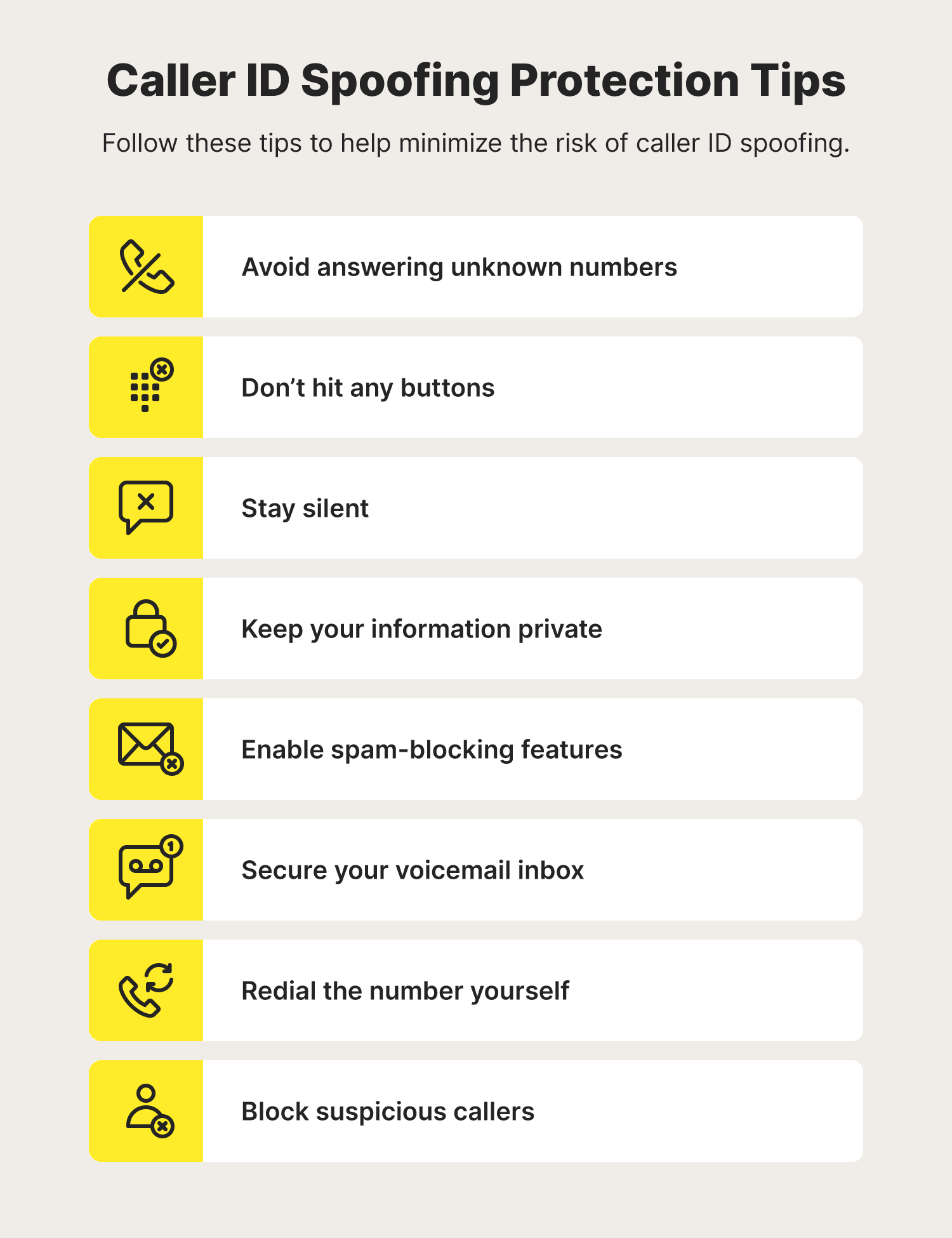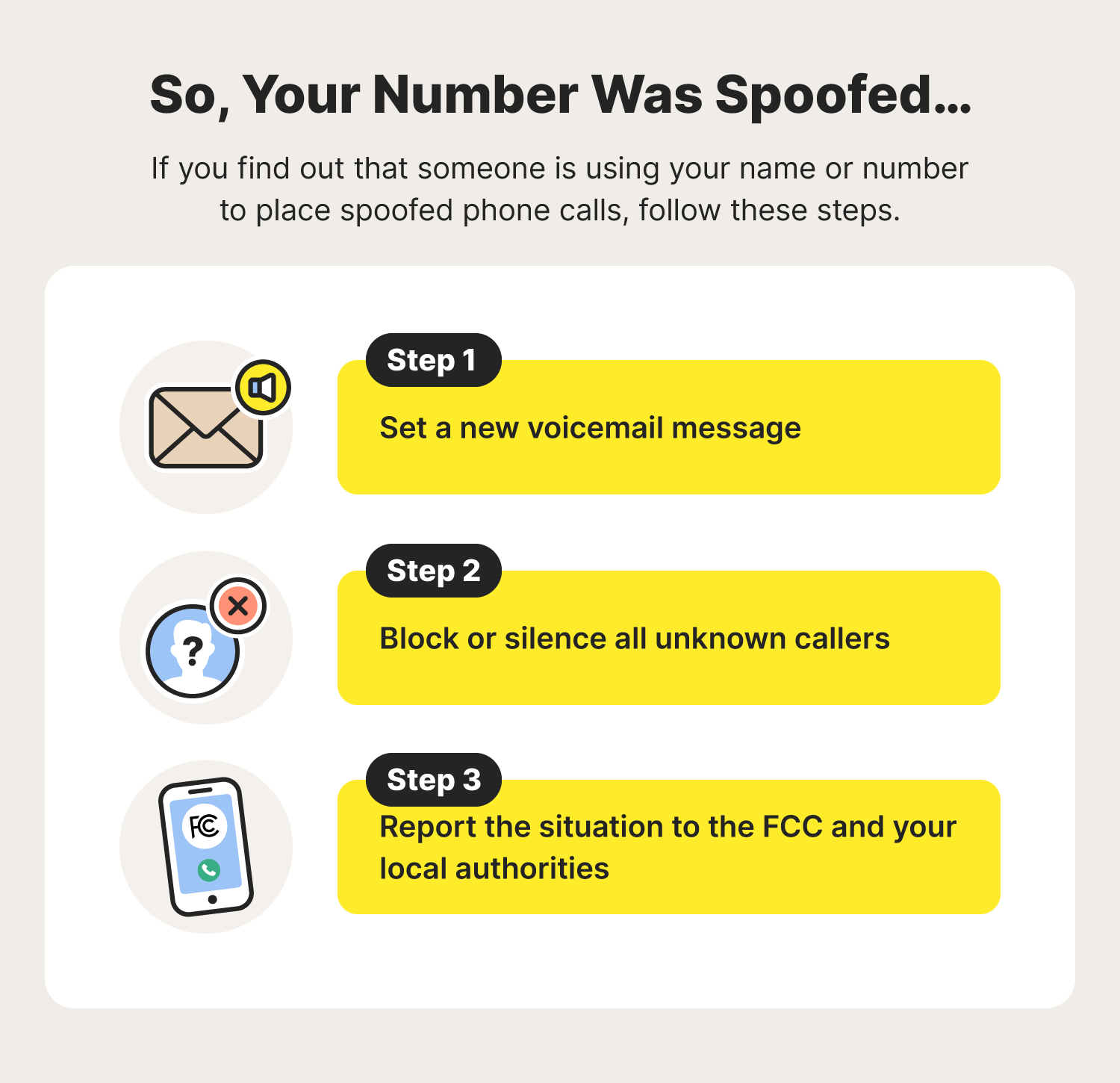Caller ID spoofing: How to spot and avoid spoofed calls
Caller ID spoofing is when someone intentionally alters the information relayed to your caller ID display to hide their identity or impersonate somebody else.

What is caller ID spoofing?
Caller ID spoofing is when someone intentionally alters the information relayed to your caller ID display to hide their identity or impersonate somebody else.
Imagine you're going about your day when your phone begins to ring, with your phone's caller ID indicating that the call is coming from your bank.
Upon answering the phone, a voice on the other end informs you that someone has hacked the password to your online banking account and that you need to provide your personal information to verify your identity and secure your account.
After following their instructions, you hang up and rush to your computer. You then discover that your account appears to be perfectly fine. As you go to call them back, you realize the number that called you doesn’t match the number listed on your bank's website.
This is possible due to caller ID spoofing, a technique used by scammers to impersonate others or disguise their own identity.
To learn more about caller ID spoofing and how to spot and avoid spoofed calls, read through this helpful guide.
How caller ID spoofing works: 3 techniques to know

With the help of caller ID spoofing, con artists can place phone calls that appear as if they are coming from somebody else. This type of phone spoofing can be implemented in different ways and may be used for vishing or other scams. To help you better understand how caller ID spoofing works, let’s explore some common spoof call methods.
VoIP spoofing
When scammers first began practicing caller ID spoofing, it required advanced technical knowledge and expensive equipment to pull off. Thanks to Voice over Internet Protocol (VoIP) technology, caller ID spoofing can be done for little to no cost without specialized equipment.
VoIP is a calling service that allows users to place calls over the internet. While this may be a great alternative to traditional calling services, it can also be used for caller ID spoofing.
This is because scammers can customize their caller ID display name when setting up their accounts, allowing them to easily impersonate someone else. In addition, VoIP services aren’t subject to the same hardware standards as landlines, which makes VoIP caller ID spoofing much easier than doing it through a traditional landline.
Because VoIP is often cheaper and easier to set up than a landline, a scammer may use it to carry out scams, such as IRS scam calls, which is when a scammer impersonates the IRS to steal your personal information.
Spoofing services
As the name suggests, spoofing services are services designed specifically to help users spoof a call. In some cases, these services are web-based platforms or third-party apps. With these services, scammers can easily customize their caller ID information either for a small fee or at no cost at all.
Because this can be as simple as downloading a free app, using a phone spoofing service can make phone number spoofing easy and accessible for scammers of all skill levels. In addition, these services can also be used to send text messages and may be used for smishing attacks.
Orange boxing
Orange boxing is an alternative method of call spoofing used to trick someone into thinking that they are receiving a call from a spoofed number when there is actually no phone call at all. This is possible using hardware or software that can mimic the signal of an incoming call, allowing the scammer to spoof the caller ID display.
Because this method of caller ID spoofing doesn’t spoof a legitimate phone call, it is often used as a social engineering technique to scare you or make you believe that someone else is trying to contact you.
How to spot caller ID spoofing: 5 red flags

With an understanding of how caller ID spoofing works, you may wonder how to spot a spoofed call. After all, the point of caller ID spoofing is to trick you into thinking you’re talking to someone else. With that in mind, there are still some red flags you can watch out for whenever you receive an incoming call, including:
- Unfamiliar number: If you recognize the caller ID display name but not the associated phone number, it may be a spoofed call.
- Pre-recorded messages: In some cases, caller ID spoofing may be used for robocalls. In these calls, you may be asked yes or no questions or to press a specific number for further instructions. As with all unknown callers, it's best to treat these as spam and hang up immediately.
- Sense of urgency: Another sign of spoofed phone calls is a sense of urgency. For example, a scammer may use caller ID spoofing to pose as a friend in danger. In this type of scam, the scammer may inform you that they are in a desperate situation and need money as soon as possible. Scammers will do this to scare you and get you to act quickly without confirming that the call is from who they say they are.
- Requests for payment or personal information: Whether you’re greeted by a recording or a live caller, spoofed caller ID calls may be used to trick you into giving up personal information, such as your Social Security number or credit card information.
- Display differs from stored contact: Another warning sign of a spoofed phone number is if the display name differs from your stored contact information. For example, if you have your friend listed as “Dave Smith” on your phone but receive a call from “David Smith,” it may be a spoofed call.
If you notice one or more of these warning signs when dealing with an incoming call, it's best to treat it as a spoofed phone call and ignore it.
How to avoid caller ID spoofing: 8 protection tips

Now that you know what to look out for, here are some protection tips you can utilize to avoid caller ID spoofing and the scams that may be associated with it.
- Avoid answering unknown numbers: Even if the caller ID display name seems familiar, avoid answering calls from unknown numbers, as they could be a scammer in disguise.
- Don’t hit any buttons: If you happen to answer a spoofed call, avoid pressing buttons or following any of their instructions. Instead, hang up immediately.
- Stay silent: If you end up answering a call you’re unsure about, it’s best to stay silent and hang up to avoid accidentally giving up any personal information.
- Keep your information private: Whenever you’re talking to someone you don’t know, be sure to avoid sharing any personal information, as a scammer could use it for malicious purposes such as identity theft.
- Enable spam-blocking features: To help minimize spam texts and calls from unknown phone numbers, be sure to enable your device’s spam-blocking features. This can help prevent a spoofed call from reaching your phone, even if the display name is familiar.
- Secure your voicemail inbox: Some scammers may even attempt to spoof your phone number to call others and access your voicemail inbox. To help stop them, be sure to secure your voicemail box with a password.
- Redial the number yourself: If you’re ever suspicious that you’re receiving a spoofed call, hang up and dial the number back yourself to ensure you are actually speaking to a legitimate caller.
- Block suspicious callers: By blocking any suspicious or unknown callers, you can reduce the number of unwanted calls your phone receives.
To block caller ID spoofed calls on an iPhone, follow these steps:
- Open the Phone app.
- Tap “Recents.”
- Select the info button (ⓘ) next to the phone number you’d like to block.
- Scroll down and select “Block this Caller.” Tap “Block Contact.”
To block spoofed calls on an Android, follow these steps:
- Open the Phone app.
- Select “Recents.”
- Long press the phone number you’d like to block.
- Tap “Block/report spam.”
- Check the “Report call as spam” box.
- Select “Block.”
Even after prioritizing all these detection and prevention tips, it’s still possible that a spoofed phone call can slip through the cracks.

What to do if your number is spoofed
While receiving spoofed calls can be annoying, having your own name or number spoofed can be even worse. If you start to hear that your identity is being used for spoof calls that you aren’t making yourself, follow these steps:
- Set a new voicemail message: To help clear up any confusion, be sure to record a new voicemail message explaining the situation. That way, anybody who calls you will know that your number has been spoofed, and it isn’t you who has been contacting them.
- Block or silence all unknown callers: Using either a call-blocking service or your phone’s settings, block or silence all unknown callers. This can help minimize the annoyance of random people calling you thinking that they are going to reach someone else.
- Report the situation to the FCC and your local authorities: To help stop telephone spoofing, be sure to file a complaint with the FCC and inform your local authorities.
Now that you’ve learned how to detect and avoid caller ID spoofing and what you can do if your number is spoofed, you can help minimize the risk of engaging with a spoofed phone call. To better increase your Cyber Safety, educate yourself on the other mobile scams that can make their way to your device.
FAQs about caller ID spoofing
Still curious about caller ID spoofing? Read along to learn the answers to some of the most frequently asked questions about caller ID spoofing.
Is caller ID spoofing illegal?
It depends. As a result of the Truth in Caller ID Act of 2009, it is illegal for any person in the United States to use caller ID spoofing with the intent to defraud, steal, or cause harm.
Because of this, caller ID spoofing is legal as long as there is no ill intent. For example, businesses may legally alter their caller ID to list a toll-free callback number, even if it’s not the number they are calling from.
Why is caller ID spoofing dangerous?
While caller ID spoofing may seem like a harmless prank, scammers can use this technique for malicious purposes, such as different types of phishing attacks. For example, a scammer may pose as a trusted entity to get you to give up sensitive information that can be used to steal your identity, money, or login information.
What is neighbor spoofing?
Neighbor spoofing is a type of caller ID spoofing in which the scammer impersonates a phone number like your own in hopes you’ll be more likely to answer. For example, if your phone number is (555) 555-0101, you may receive a call from (555) 555-0102.
What is blocking or labeling on your caller ID?
Blocking or labeling on your caller ID is when an incoming call is automatically blocked or labeled as “potential spam,” “spam,” or another similar description, depending on your device.
This is because the FCC allows telephone providers to automatically block phone numbers proven to be used for spam purposes.
Do telemarketers have caller ID rules?
Yes. All telemarketers must provide the appropriate number from which the phone call is coming. In addition, the phone number must be reachable during regular business hours in case you’d like to call and request that they no longer contact you.
Can you find out who spoofed your number?
Unfortunately, it is very difficult to find out who exactly has been spoofing your number. Depending on the specific method the scammer used, tracking down who has been spoofing your number may only be possible by contacting law enforcement or your telephone company.
What are the legitimate reasons for caller ID spoofing?


Help protect your digital life on your devices.
Are you afraid of losing your personal information or all the precious things on your computer? Get comprehensive protection with Norton Security Deluxe across all your devices – up to 5 PCs, Macs, smartphones or tablets.
Create an account today and try it free for 30 days on up to 5 of your devices.
While caller ID spoofing is commonly used by scammers, there are instances in which it is used legitimately. For example, those involved in journalism or law enforcement may decide to use caller ID spoofing to privately place calls without disclosing their identity, phone number, or location.
Editorial note: Our articles provide educational information for you. Our offerings may not cover or protect against every type of crime, fraud, or threat we write about. Our goal is to increase awareness about Cyber Safety. Please review complete Terms during enrollment or setup. Remember that no one can prevent all identity theft or cybercrime, and that LifeLock does not monitor all transactions at all businesses. The Norton and LifeLock brands are part of Gen Digital Inc.





Want more?
Follow us for all the latest news, tips, and updates.